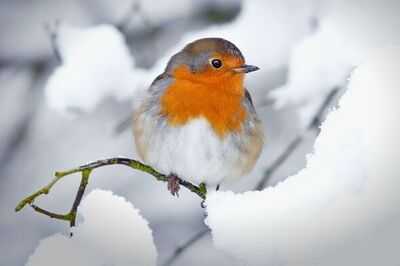
With their bright red breasts and confident hops, robins are one of the most beloved sights of the British winter.
They've been voted the nation's favourite bird, have adorned Christmas cards since Victorian times, and their cheerful song carries on even during the coldest months of the year.
But behind the festive image lies a harsher reality - winter can be a life-or-death challenge for these small birds, and gardens often make the difference between survival and starvation. Unlike many species that migrate, robins stay put, fiercely defending their territories through freezing nights and short, dark days.
Their strategy is to remain faithful to the same gardens year-round, so if you can make your patch welcoming in November and December, they're likely to return day after day - and even nest there come spring.
There are a number of simple, practical steps anyone can take to help these birds through the toughest months of the year. From what to feed them to where to hang nest boxes, these are the best ways to encourage robins to visit your garden this winter.
The most important starting point is food. As temperatures drop, robins need a constant supply of high-energy nutrition to survive. They're primarily insectivores, which means their natural diet consists mainly of worms, beetles and other invertebrates found close to the ground.
In cold spells, when the earth hardens and snow covers their foraging spots, it becomes much harder for them to find what they need. That's where supplementary feeding makes a real difference.
Experts recommend offering mealworms - either live, dried or soaked - as one of the best foods for robins, thanks to their high protein content and similarity to natural prey. Fat-based foods such as suet pellets, bird cake or fat balls are also invaluable, providing concentrated calories to help robins maintain their body temperature.
Placing food on a bird table, low tray, or scattering it on lawns and flowerbeds near shrubs works best, and a sheltered corner close to a hedge or tree gives them a safe vantage point and encourages repeat visits.
Mild cheese, crushed peanuts, dried fruit and meaty kitchen scraps can all be added to the mix, along with special high-protein robin blends available from wildlife suppliers.
WaterThe second essential step is to provide water. This is often overlooked in winter, but it can be just as important as food. Natural water sources may freeze, so keeping a bird bath topped up and breaking any ice ensures robins have somewhere to drink and bathe.
Regularly refreshing the water helps prevent bacteria building up, and placing the bath in a quiet spot near cover makes birds feel secure while they drink.
ShelterCreating suitable shelter is the third key factor. Robins, like many small birds, need places to roost on cold nights to conserve energy. While some may find shelter in hedges, climbing plants or dense shrubs, nest boxes are also used in winter as night roosting sites.
Open-fronted designs are best for robins, ideally tucked away behind foliage or ivy to offer protection from predators. Placing them between north and east helps avoid strong sunlight and rain, and positioning them around two metres from dense vegetation reduces the risk of cats ambushing. These same boxes are often later used for nesting in early spring, so putting them up now gives robins time to get familiar with the space.
The fourth tip is to resist over-tidying. A garden that's slightly wild around the edges is far more attractive to robins than one that's overly pristine. Leaving some undergrowth, fallen leaves and decaying logs encourages insect populations, which in turn provide a steady food source.
A log pile or compost heap is ideal, offering warmth, shelter and food for invertebrates through the winter. Allowing ivy to flourish in certain corners creates natural cover for robins to hide and forage in.
SafetyThe sixth way to encourage robins is to make them feel safe. These birds are bold - many gardeners have stories of robins hopping close while they dig, waiting for worms to appear - but they're also territorial and cautious of predators.
Hanging feeders or placing food too close to dense vegetation makes it easier for cats to launch surprise attacks. Keeping feeding spots about two metres away from cover allows robins to dart for safety if needed, without leaving them vulnerable.
ConsistencyFinally, a seventh and often overlooked tip is consistency. Robins can quickly become accustomed to reliable sources of food and shelter, and putting food out at roughly the same time each day helps them learn when to visit.
Once they trust the space, they may return daily and even feed from the hand after some weeks. In many gardens, robins become long-term regulars, returning to the same spots winter after winter.
You may also like

How to play FM26 beta - Last chance to play Football Manager 26 before release

Meet the England rugby team's WAGs including fitness trainer, war refugee and singer

Amanda Owen's gorgeous names for her nine children and what they are doing now

Gold records 2nd weekly loss amid hopes of US trade deals with India, China

BBC legend reacts to Tess Daly and Claudia Winkleman's exit after 'replacement' news






